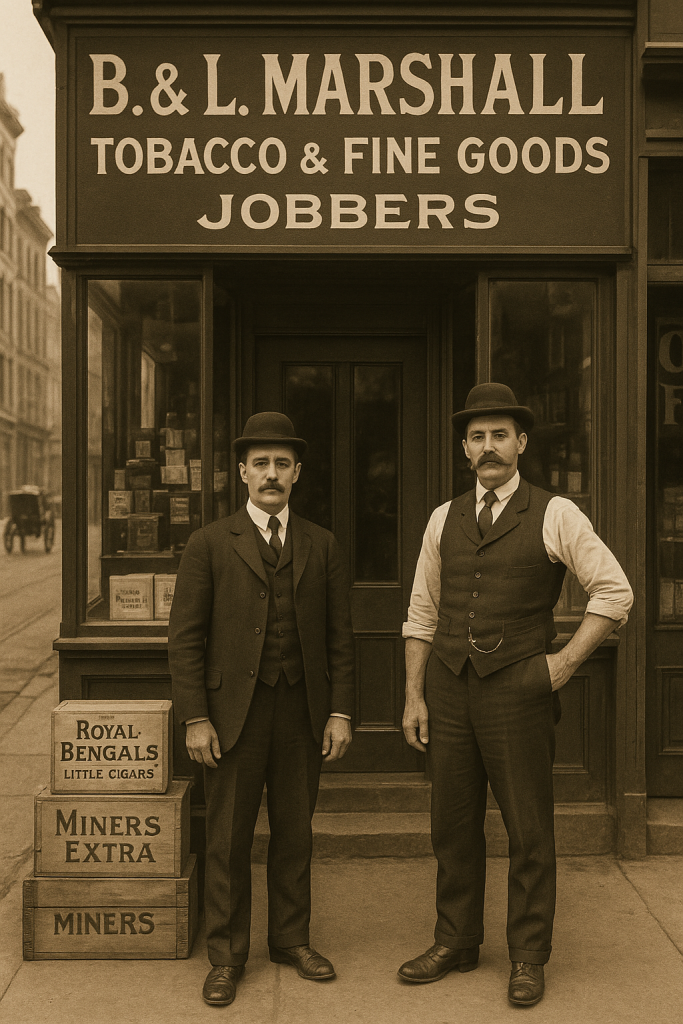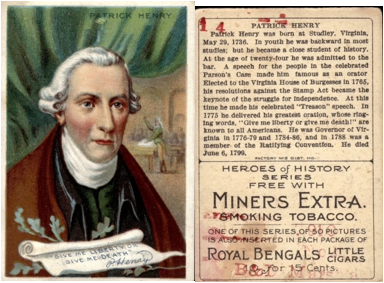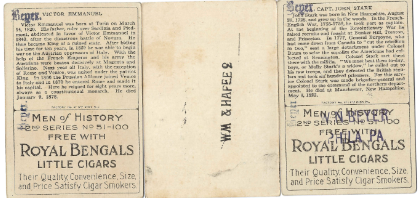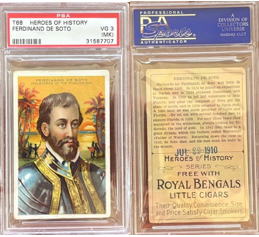By DB Sikes

Jobber (n.): In early 20th-century commerce, a jobber was a wholesale merchant or middleman who purchased large quantities of goods directly from manufacturers and resold them to retailers, smaller distributors, or other businesses. In the tobacco trade, jobbers often added their own identifying marks or stamps to packaging, serving both as branding and as a way to track distribution
Card Subject Overview
Jobber stamps small, often overlooked marks on the backs of tobacco cards, represent one of the most intriguing sub-threads in T68 collecting. These stamps were typically applied by tobacco wholesalers, distributors, or local “jobbers” who moved large quantities of product to retail outlets. While sometimes seen on sports issues like T206 baseball cards, stamped backs on T68 “Heroes of History” are scarcer, and each discovery offers a tangible link to the trade networks that brought these cards to consumers.

The Fictitious Backstory – A Day at B & L Marshall, 1911
It’s a brisk March morning in Philadelphia, 1911. The city hums with the clatter of trolley wheels and the chatter of dockworkers unloading goods at the Delaware River piers. On Market Street, a modest storefront bears a painted marquee: B & L MARSHALL – TOBACCO & FINE GOODS JOBBERS.
Inside, the air is thick with the aroma of cured leaf and the faint sweetness of cigar smoke. Stacks of Royal Bengals Little Cigars, Miners Extra Smoking Tobacco, and Pan Handle Scrap chew are piled neatly behind the counter. Ledger books lie open, recording shipments bound for corner grocers, billiard halls, and small-town general stores across Pennsylvania.
Two men stand out front before the day’s deliveries begin: Benjamin Marshall, the elder partner with a neatly trimmed mustache and bowler hat, and his younger brother Louis, sporting a handlebar mustache and double-breasted waistcoat. They’ve just received a fresh case from Factory No. 5 in Maryland. Before the boxes are sent on their way, each packet is stamped with the B & L Marshall mark—a sign to retailers that they came from a trusted Philadelphia supplier.
For Benjamin and Louis, it’s more than just a stamp, it’s their brand in an era when word-of-mouth and reputation kept business alive. For today’s collectors, that faint purple or red marks are a century-old handshake between jobber and customer.
Research Notes
- Jobber stamps on T68 cards are rare, often unique to specific regions.
- The B & L Marshall example is tied through storytelling to Philadelphia, Pennsylvania, The Beyer Stamp shown below clearly has a PHILA. PA endorsement reinforcing the theory that some stamps were used as territorial identifiers for product batches.
- Placement on the card’s back was typically low or center, avoiding key text but still visible enough to deter resale without the jobber’s mark.
- Unlike modern retail labeling, these stamps were applied individually, making font variations and ink saturation unique to each mark.

The Role of Date Stamps
An additional layer of intrigue comes from date stamps, such as the bold JUL 29 1910 impression seen on the Ferdinand De Soto card. While not as common as jobber names, these stamps often served a practical role in tobacco distribution. They may have been applied to mark shipment dates, track inventory rotation, or document when a lot of cigars left the wholesaler’s hands.
For collectors, these marks provide something invaluable: a time-stamped snapshot of the card’s journey. In this case, the July 1910 date pushes the provenance back to within months of the set’s initial circulation. Much like postmarks on vintage envelopes, these impressions root the card in a specific moment of the trade network, offering both historical validation and collecting charm.

Personal Reflection
Finding a T68 with a jobber or date stamp is like opening a window into the commercial life that surrounded these cards. The front lithograph tells the story of Ferdinand De Soto or Patrick Henry. The faint purple or blue stamp on the back whispers of jobbers, shipments, and store counters. It is this intersection—between celebrated history and forgotten commerce—that deepens the romance of collecting.
Call for Contributions
The B & L Marshall stamp and the July 29, 1910 date stamp are just two known pieces of this puzzle. Each discovery expands our understanding of early 20th-century tobacco distribution and its role in carrying the Heroes of History set across America.
If you have T68 cards—or other period tobacco issues—bearing unusual jobber or date stamps, please consider sharing them with T68 Masters. Documenting these forgotten distribution traces will help map the networks that made this set part of everyday life over a century ago.
Leave a Reply